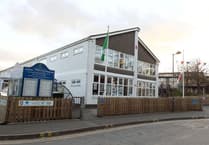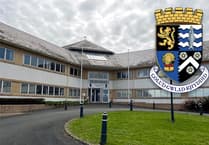A bid to remove, restore and save a historic organ from a now closed church has been approved by Gwynedd Council planners.
St David’s Church at Glanadda, Bangor, closed its doors in 2014 and is currently on the market.
But the 1906-built organ is now set to be restored and eventually rebuilt at the Mary Harris Memorial Chapel, which forms part of the University of Exeter college campus, following a warning that further damp conditions and lack of use could render it unplayable.
Having been approved by Gwynedd Council’s planning department, with no objections being raised by Bangor City Council on the proviso that efforts had been made to find a more local venue, it was submitted by David Davies, on behalf of the University of Exeter and Gary Owens, Organbuilders.
The supporting document stated: “The instrument in question was built by the hugely distinguished firm William Hill & Son in 1906.
“It was conceived as a new instrument for St David’s Church in Bangor, Gwynedd, a fine building (by Arthur Bloomfield, 1888) raised on the heels of the financial successes of the railway, and the advent of a new university.
“Sadly, of course, such dynamism ebbed as the twentieth century progressed, and the railway is no longer the focal powerhouse of North Walian industry.
“St David’s Church, like others, lost its support and financial independence, so much so that, in 2014, the church closed.”
With the church currently on the market for an asking price of £150,000, with covenants in place restricting certain uses, the applicants went on to state: “The organ is the last piece of the interior furnishing to remain in situ.
“The church has been without heating for some years, and, although the organ will not suffer any structural damage (unless the church fabric around it deteriorates), a combination of damp conditions and a lack of its use will conspire to render it unplayable.
“This is not to say that it is not able to be fully refurbished, merely that it is in a hostile environment, and its removal to the safety of a dry and controlled storage unit is its only option for survival.
“The quality of the craftsmanship in the organ is undisputed, and, although not large, the sound of the organ has many of the hallmarks of what is known in the organ world as the ‘Truro’ effect.
“The Willis organ at Truro Cathedral is counted among the smallest cathedral organs in the country, yet, by sheer virtue of its scaling to the size of John Loughborough Pearson’s magnificent structure, it succeeds in enveloping the acoustical space with a relatively small number of organ stops.
“This scheme proposes the acquisition, storage and restoration of the organ before it is rebuilt in the gallery of the Mary Harris Memorial Chapel.”
The planning officers’ report, who approved the listed building consent application without the need to go in front of councillors, noted: “The building has been closed for some time and is for sale.
“With no funding available from the Church in Wales to restore and preserve the organ, another home has been found within another chapel where the organ would be active again.
“The fact that the organ needs to be removed from the building is sad, but because of the organ’s importance it is important to declare a new home for it and a home where the organ would be back in operation.
“The application states that the organ would go to the University of Exeter, within a chapel where the organ would be used.
“It is considered that having a photographic record of the organ in place before removing it would be acceptable to record the history.
“It is inevitable that the proposal would affect the integrity of the property, but without securing the organ’s long-term future through this procedure it is not possible to secure its future to continue in the building as the property is for sale and in decline as well as anti-social issues.”




